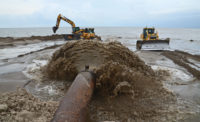Plans are moving forward on two major Mississippi River sediment diversion projects, considered crucial to rebuilding Louisiana’s coast. The state has started to look for an engineering and design firm for one of the diversions and, in December, will begin to look for a contractor for the other.
In July, the state tapped AECOM to oversee project management, engineering and design for the proposed $1.3-billion Mid-Barataria Diversion Project. The Coastal Protection and Restoration Authority (CPRA), the state agency overseeing the state’s $50-billion master coastal plan, hopes to have 15% of the design completed and negotiate a construction manager-at-risk (CMAR) contract for the project by September 2018. In October 2017, the state began to advertise for an engineer and designer for a second project, the $800-million mid-Breton diversion.
Helping those efforts will be a new, state-of-the art physical model of the lower Mississippi that will open in January in the state’s new Baton Rouge water campus. The model will help engineers and scientists to examine how diversions will affect each other and the impact of river dredging. The model will help CPRA to pinpoint the optimal placement for the mid-Breton diversion among three sites under consideration. Other diversions and options were routed into the model. The 90-ft by 120-ft model, created by Alden Labs and installed by BCG Engineering (now King Engineering), consists of 216 high-density, 5-ft by 10-ft foam panels. The model was created with a router that used 3D CAD files that used 4 million points of data. The panels were installed atop a mile of steel beams. The water and sediment flow of the river will be controlled by computer and illustrated by 20 projectors, typically used to craft halftime graphics for NBA broadcasts.
“It’s one of a kind in terms of what we are trying to do,” says Clint Willson, a civil and environmental engineering professor at Louisiana State University. He ran a smaller, precursor river model on the LSU campus and will be in charge of operating the new model. “It gives us the ability to model the river and the sand and sediment moving through. We’re pushing the science,” he says. Information from the model will supplement information from computer modeling as well as data collected on the river by the Army Corps of Engineers. A minute of the model equals one week on the river and one hour equals a year, faster than a 3D computer model.
The model is housed in an $18-million, 45,000-sq-ft building that will include exhibits aimed at public outreach and getting middle- and high school students interested in working on restoring Louisiana’s coast. “The people who don’t support the sediment diversion—they don’t believe the computer modeling—this is a controlled situation,” says Rudy Simoneaux III, engineer manager for CPRA. “You can put a parish president on that bridge and say, ‘All we did is shrink the river.’ ”
Through the projection, the model can illustrate what will happen if the diversions aren’t built and how the coast will be impacted by sea-level rise. The model represents a 14,000-sq-mile section of southeastern Louisiana, or 179 miles of the river, at a 1:6,000 horizontal scale.






Post a comment to this article
Report Abusive Comment